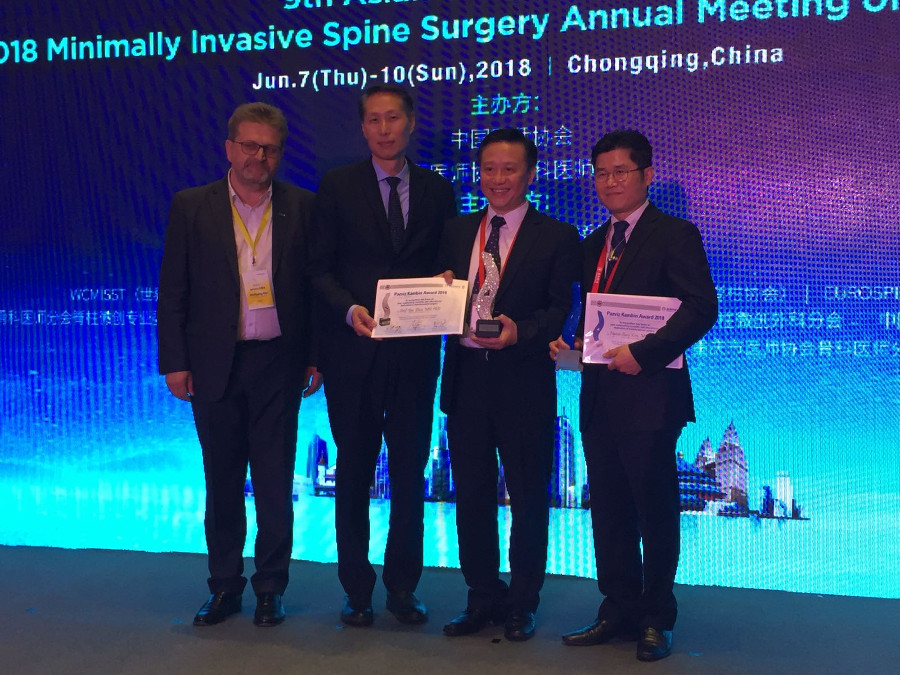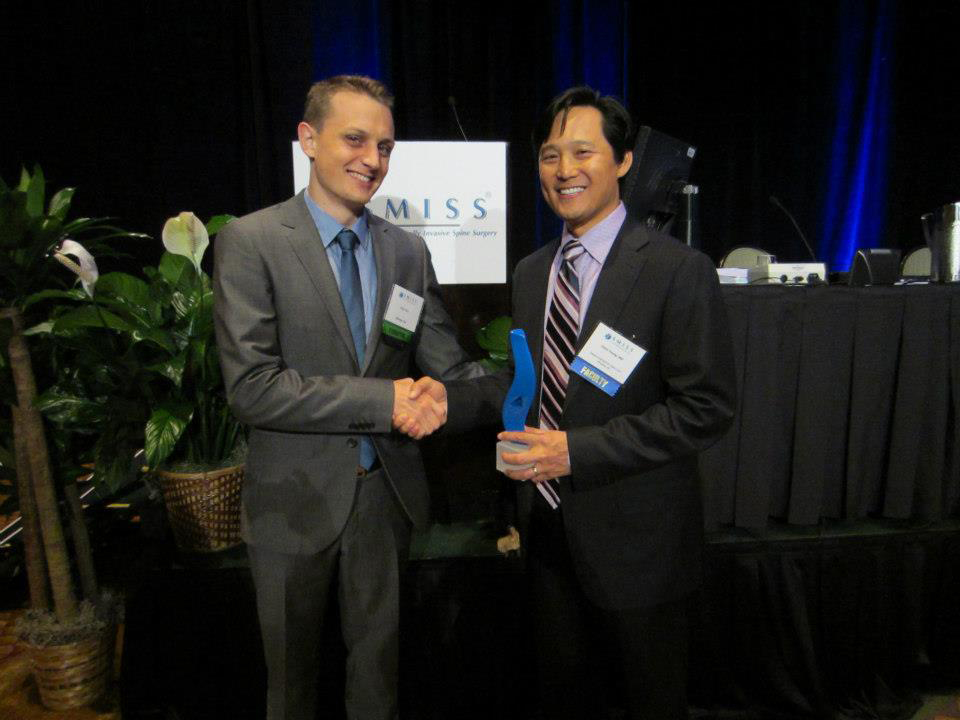The Parviz Kambin Award
Together with SMISS (Society of Minimally Invasive Spine Surgery), joimax® established the Parviz Kambin Award in 2011. The award honors spine surgeons who have notably excelled in advancing endoscopic spine surgery, particularly in the use of transforaminal access techniques.
Dr. Parviz Kambin and the “Kambin Triangle“
Dr. Parviz Kambin was the first surgeon worldwide who described the transforaminal endoscopic access to disc herniation1. In a series of experimental tests, he identified a workspace within the intervertebral foramen through which the spinal canal can be accessed safely. Because this safe zone is somewhat triangular shaped, it was named the “Kambin Triangle.“
The posterolateral transforaminal access route offers some significant advantages compared to conventional posterior approaches. Since the foramen is a natural opening to the spinal canal, no muscles, no bone and no ligaments need to be resected to access the spinal canal. Therefore, it is a far more gentle tissue-sparing technique as compared to microsurgery. It presents less scarring, less complications and a faster recovery, thereby speeding up the time for patients to return to work2,3,4,5,6,7,8.
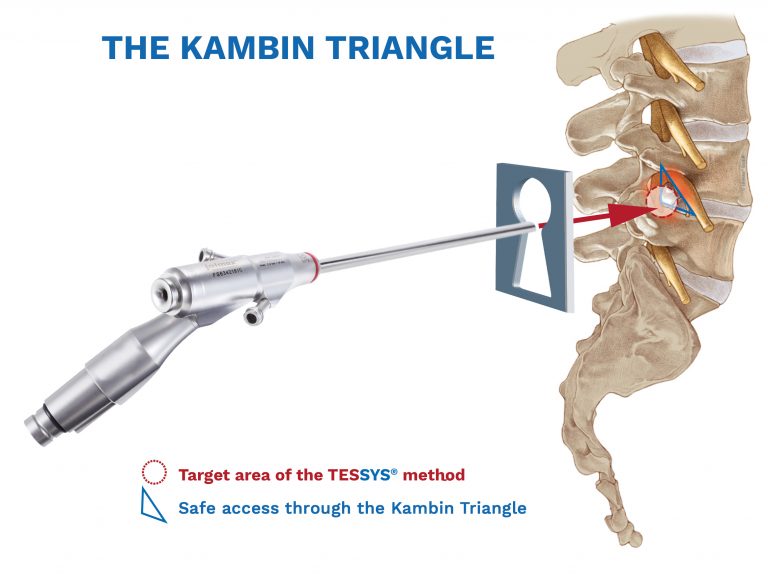
“Keyhole” Operations
Based on all those aspects, Dr. Parviz Kambin has significantly helped to lay the groundwork for endoscopic minimally invasive spinal surgery, especially for the transforaminal access technique “TESSYS®” (Transforaminal Endoscopic Surgery System). This access, through the opening in the intervertebral foramen, is considered by experienced surgeons to be the most delicate procedure currently available – the ”gold standard“ in disc surgery.
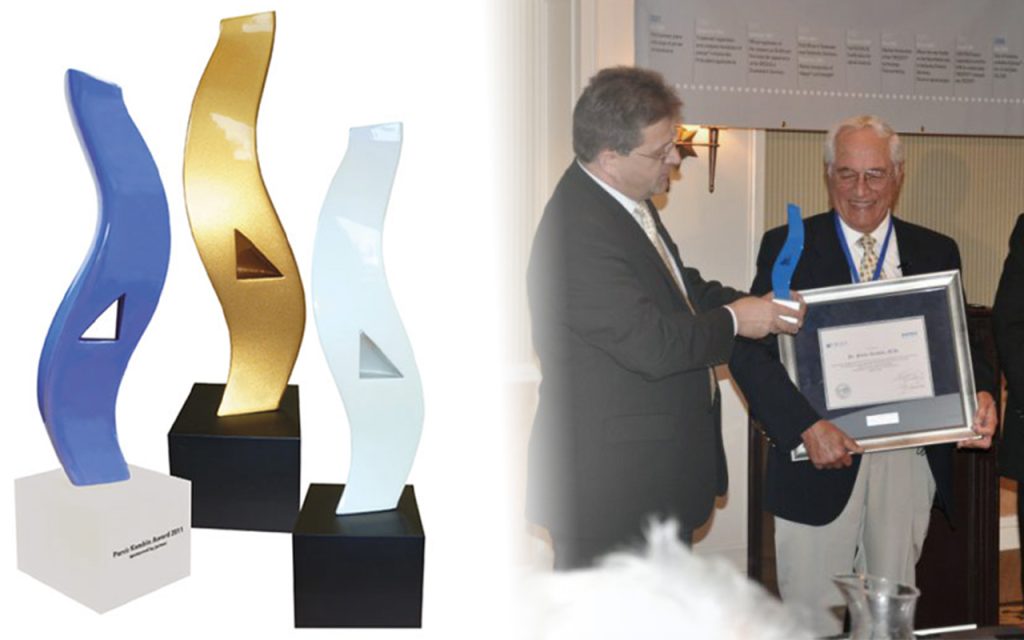
The Parviz Kambin Award was inaugurated by Wolfgang Ries and introduced in 2011 by SMISS (Society of Minimally Invasive Spine Surgery). It is meant to honor spine surgeons who are especially committed to the advancement of endoscopic spine surgery – particularly the transforaminal techniques.
Criteria for being nominated for the Kambin Awards are:
Blue Kambin Award: Scientific publications and presentations at leading congresses. Strong commitment to clinical research and training.
Pearl Kambin Award: Exceptional scientific achievements.
The Golden Kambin Award: Nomination and the decision of the scientific committee.

Award Winners
2023
Dr. Frank Hassel, in recognition and honor of his outstanding scientific and educationals dedication to endoscopic spinal surgery, presented at the first ESPINEA® World Summit in Edinburgh.
J.N. Alastair Gibson DSc MD FRCSEd FRCS(Tr & Orth) MFSTEd, in recognition and honor of his outstanding scientific and educationals dedication to endoscopic spinal surgery, presented at the first ESPINEA® World Summit in Edinburgh.
2022
Junseok Bae, MD, in recognition and honor of their outstanding scientific and educationals dedication to endoscopic spinal surgery, presented at the first ESPINEA® APAC Community Meeting in Singapore.
Michael Wang, MD, in recognition and honor of their outstanding scientific and educationals dedication to endoscopic spinal surgery, presented at the inaugural ESPINEA® Americas Community Meeting in Irvine.
2019
Christoph Hofstetter, MD, PhD, Jian Shen, MD, PhD and Dinh Ngoc Son, MD, in recognition and honor of their outstanding scientific and educationals dedication to endoscopic spinal surgery.
Albert Telfeian, MD, PhD received a special scientific Kambin Achievement Award for his outstanding publication work since years.
Parviz Kambin Awards were presented to all recipients at the joimax® Faculty & User Meeting together with ESPINEA® in 2019 in Salzburg.
Sang-Ho Lee, MD, for his lifetime achievement and commitment to endoscopic spinal surgery. The award was given to his successor, Junseok Bae, MD, during KOMISS in Seoul, Korea as he could not be present.
2016
Dr. Guntram Krzok, Prof. Dr. Alastair Gibson and Dr. Ralf Wagner in recognition and honor of their outstanding scientific and educational dedication to transforaminal surgery.
Dr. Krock recieved his award at the WCMISST Korea 2016 in June, Prof. Dr. Gibson and Dr. Wagner got awarded during the User Meeting between PMU and joimax® in Salzburg that year.
2015
Albert Telfeian, MD, PhD and Gabriele Jasper, MD in recognition of their outstanding scientific and educational dedication to transforaminal surgery. The two surgeons tremendously contributed to this field with numerous high quality publications. They are treading new paths for spinal endoscopy.
Dr. Menno Iprenburg for his lifetime achievement. He successfully treated more than 2,400 patients suffering from disc herniations.
All three recipients got awarded together with the University of Mainz at a joimax® User Meeting held in 2015.
Sang-Ho Lee, MD, PhD for his longstanding scientific and educational dedication to transforaminal surgery. He incredibly contributed to this field with numerous high quality publications.
Dr. Lee got awarded together with the NASS and joimax® at the annual meeting.
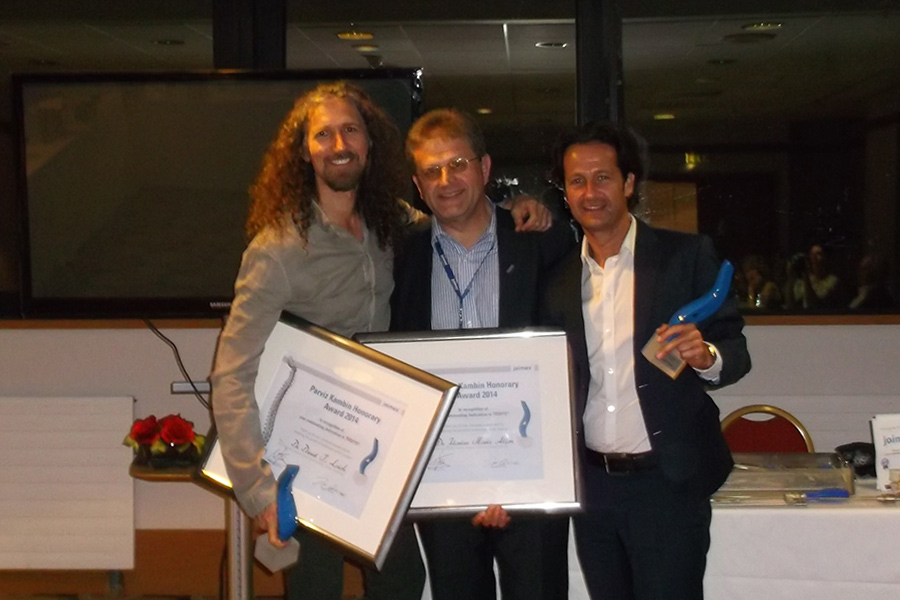
2014
Dr. Florian Maria Alfen as one of the pioneers performing the TESSYS® technique, with more than 2,500 successfully treated patients.
Daniel Laich, DO as the first-time adopter of the TESSYS® technique in the United States and a long-time faculty member. Both recipients got awarded around the WCMISST meeting held in Paris that year.
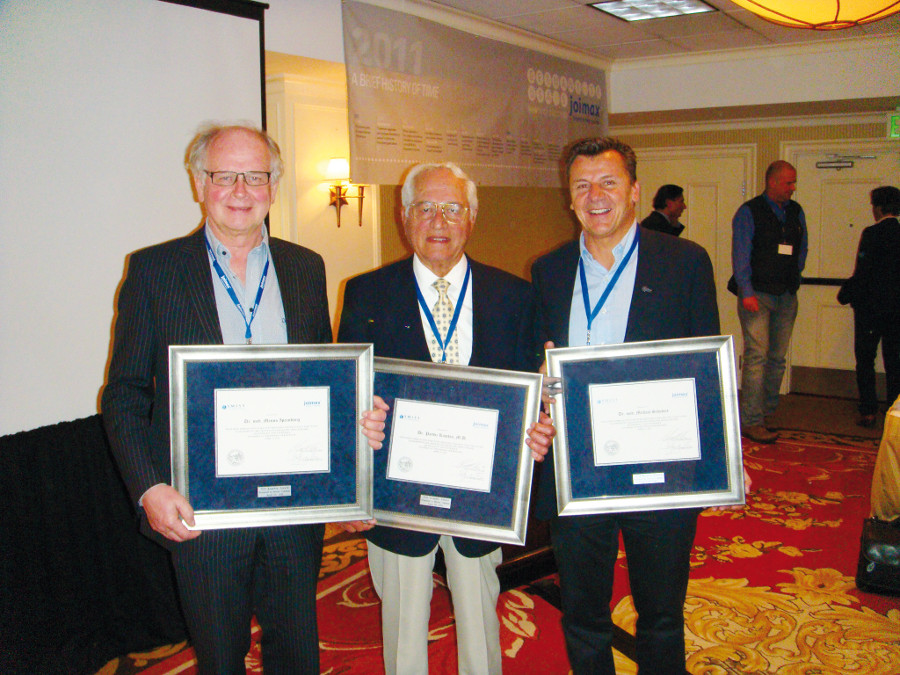
2011
Parviz Kambin, MD, PhD himself, as recognition of his pioneering work in transforaminal endo-scopic spinal surgery.
Dr. Michael Schubert who has successfully performed the highest numbers of surgeries until 2011, with the so-called „intra channels“ TESSYS® technique. This method and technology is a further development of the original access technique. TESSYS® was originally developed by joimax® together with Dr. Thomas Hoogland.
Dr. Menno Iprenburg who is one of the most dedicated surgeons in this field. He is convinced that this method will become the new “gold standard“ for spinal surgery. Dr. Iprenburg renounced his position as chief surgeon to open his own private clinic to perform the TESSYS® technique. He has successfully performed more than 1,800 cases.
All three recipients got rewarded by the SMISS together with joimax® prior to the AANS meeting held in Denver in 2011.
Dr. Parviz Kambin
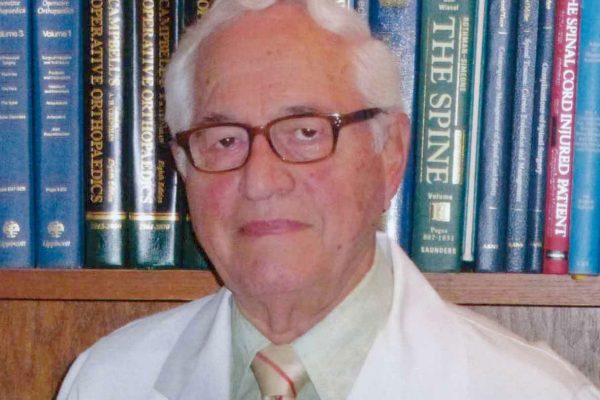
Dr. Parviz Kambin (May 21, 1931 – March 29, 2020) was born in Tehran, Iran.
He received his doctorate degree in medicine from Tehran University Faculty of Medicine in 1956. He continued his post-graduate training as an intern at St. Joseph‘s Regional Medical Center.
He then moved on to do a four-year residency at New Jersey Orthopaedic Hospital and New York University, and received his American Board Certification in Orthopaedic Surgery in 1965.
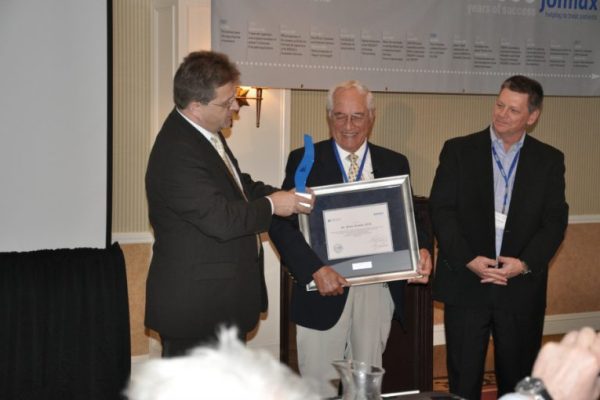
Kambin was a Professor of Orthopaedic Surgery and had an Endowed Chair of Spinal Surgery at Drexel University, College of Medicine.
He has been recognized by the College of Physicians of Philadelphia and his work in part has been exhibited in the Mutter Museum. Together with several colleagues, he assisted in the establishment of the International Society for Minimal Intervention in Spinal Surgery in 1988 and was elected the first president of the society in 1990. He coined the term „Minimally Invasive Spinal Surgery“ and was credited in the Dorland‘s Medical Dictionary for describing the Kambin Triangular Working Zone.
Parviz Kambin‘s contributions to the field of spinal surgery have been recognized both in the medical circle and the surgical industry. Kambin‘s early experimental work, with the debulking of the nuclear mass began in 1970.

By utilising a series of cadaveric studies at the University of Pennsylvania and The Graduate Hospital, Philadelphia, he developed instruments and described the anatomy and the path of the lateral access to the spinal canal for access and removal of the herniated disc fragments.
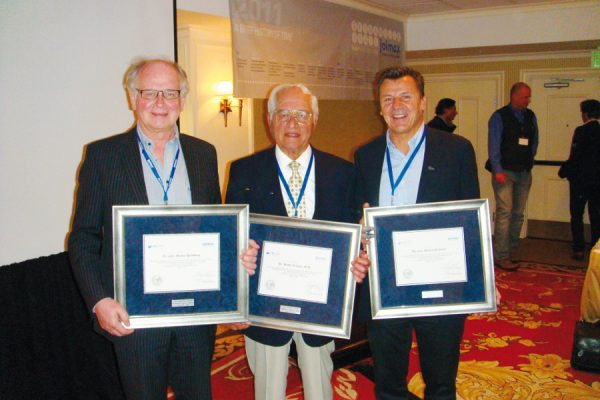
He subsequently began his experimental work on the efficacy of the postero-lateral access to the herniated lumbar discs.
Kambin‘s preliminary study of nine patients who underwent lateral discectomy was published in the peer-reviewed Journal of Clinical Orthopaedics and Related Research in April 1983, and is considered to be the first publication on this subject in western literature9,10.
He was also credited with 34 US and European patents in the field of minimally invasive spinal surgery.
Parviz Kambin passed away early in 2020, aged 88.
- Kambin P. / Gellman H. (1983): Percutaneous lateral discectomy of the lumbar spine. A preliminary report. IN: Clin Orthop. 174: pp 127-132.
- Kambin P. et al (1999): A prospective, randomized study comparing the results of open discectomy with those of video-assisted arthroscopic microdiscectomy. IN: Journal of Bone and Joint Surgery. Juli, 81(7), pp 958–65.
- Hoogland T. (2003): Transforaminal endoscopic discectomy with foraminoplasty for lumbar disc herniation. Surgical Techniques, IN: Orthopaedics and Traumatology. 55(120), C-40.
- Hoogland T. et al (2008): Endoscopic transforaminal discectomy for recurrent lumbar disc herniation: a prospective. cohort evaluation of 262 consecutive cases. IN: Spine, Apr 20, 33(9), pp 973-8.
- Iprenburg M. (2007): Transforaminal Endoscopic Surgery. Technique and Provisional Results in Primary Disc Herniation, IN: European Musculoskeletal Review 2007, Issue 2.
- Gibson JNA. et al./(2012): Transforaminal endoscopic spinal surgery. The future ‘gold standard’ for discectomy? A review. The Surgeon, doi:10.1016/j.surge.2012.05.001.
- Yeung Anthony T. / Yeung Christopher A. (2011): Posterolateral Endoscopic Lumbar Discectomy. IN: North American Spine Society/ AAOS, Advanced Reconstruction. Spine. pp 611-623.
- Jasper G. et al (2013): Clinical succes of transforaminal endoscopic discectomy with foraminotomy: A retrospective evaluation. IN: Clin Neurol Neurosurg (2013), http://dx.doi.org/10.1016/j.clineuro.2013.05.033.
- Yeung, AT; Tsou, PM (April 1, 2002). „Posterolateral endoscopic excision for lumbar disc herniation: Surgical technique, outcome, and complications in 307 consecutive cases.“. Spine 27 (7): 722–31. PMID 11923665.
- Hoogland, Thomas; Schubert, Michael; Miklitz, Boris; Ramirez, Agnes (November 2006). „Transforaminal Posterolateral Endoscopic Discectomy With or Without the Combination of a Low-Dose Chymopapain: A Prospective Randomized Study in 280 Consecutive Cases“. Spine 31 (24): E890–E897. doi:10.1097/01.brs.0000245955.22358.3a.
